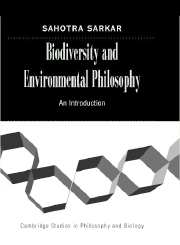Book contents
- Frontmatter
- Contents
- Preface
- Acknowledgments
- Biodiversity and Environmental Philosophy
- 1 Introduction
- 2 Concern for the Environment
- 3 Intrinsic Values and Biocentrism
- 4 Tempered Anthropocentrism
- 5 Problems of Ecology
- 6 The Consensus View of Conservation Biology
- 7 Incommensurability and Uncertainty
- 8 In Conclusion: Issues for the Future
- References
- Index
6 - The Consensus View of Conservation Biology
Published online by Cambridge University Press: 17 July 2009
- Frontmatter
- Contents
- Preface
- Acknowledgments
- Biodiversity and Environmental Philosophy
- 1 Introduction
- 2 Concern for the Environment
- 3 Intrinsic Values and Biocentrism
- 4 Tempered Anthropocentrism
- 5 Problems of Ecology
- 6 The Consensus View of Conservation Biology
- 7 Incommensurability and Uncertainty
- 8 In Conclusion: Issues for the Future
- References
- Index
Summary
Turning, finally, to the biological subdiscipline of conservation biology, in one sense it is possible not only to place and date, but even to time when that subdiscipline formally emerged as an organized field of research: at about 5 p.m. (EST), 8 May 1985, in Ann Arbor, Michigan, at the end of the Second Conference on Conservation Biology. Two ad hoc committees, chaired by Jared Diamond and Peter Brussard, had met during the conference to discuss the need for a new society and a new journal. Following their reports, an informal motion to found the society was passed, and Michael E. Soulé was given the task of organizing it. A decision was also made to found a new journal, Conservation Biology. The fact that a successful European journal devoted to the same topic, Biological Conservation, had been in existence since 1968 apparently went unnoticed. In retrospect, participants at the Ann Arbor conference seem to have been strangely convinced that they were boldly going where no one had gone before. This reflected little more than the persistent myopia of the biodiversity conservation community in the United States during that period, a point that will be of importance later in the discussion of the relatively slow emergence of a consensus view of the aims and structure of conservation biology.
In North America, in order for conservation biology to emerge successfully as an academic discipline, things moved quickly from the Ann Arbor conference.
- Type
- Chapter
- Information
- Biodiversity and Environmental PhilosophyAn Introduction, pp. 145 - 184Publisher: Cambridge University PressPrint publication year: 2005



